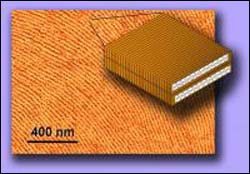Materials Sciences
Materials management deals with the research, development, manufacturing and processing of raw and industrial materials. Key aspects here are biological and medical issues, which play an increasingly important role in this field.
innovations-report offers in-depth articles related to the development and application of materials and the structure and properties of new materials.

Researchers discover that nanoparticle shows promise in reducing radiation side effects
Using transparent zebrafish embryos, researchers at Jefferson Medical College in Philadelphia have shown that a microscopic nanoparticle can help fend off damage to normal tissue from radiation. The nanoparticle, a soccer ball-shaped, hollow, carbon-based structure known as a fullerene, acts like an “oxygen sink,” binding to dangerous oxygen radicals produced by radiation.
The scientists, led by Adam P. Dicker, M.D., Ph.D., and Ulrich Rodeck, M.D., see fullerenes as a potentially “new

Common clays investigated for use as high tech environmental catalysts
Textural properties as a function of the starting mineral particle size
Development of new clean technologies in accordance with increasingly demanding environmental legislation requires new catalysts, adsorbents and/or catalyst supports. Clays have been identified as a promising materials resource for this application.
More specifically, Pillared Inter-Layered Clays (PILCs) have been identified as suitable for these purposes. However, their widespread use has been delayed by d

Study sets benchmark properties for popular conducting plastic
Results essential to optimize materials for diverse applications
Steadily increasing the length of a purified conducting polymer vastly improves its ability to conduct electricity, report researchers at Carnegie Mellon University, whose work appeared March 22 in the Journal of the American Chemical Society. Their study of regioregular polythiophenes (RRPs) establishes benchmark properties for these materials that suggest how to optimize their use for a new generation of diverse mat

Magnetism shepherds microlenses to excavate ’nanocavities’
A Duke University engineer is “herding” tiny lenses with magnetic ferrofluids, precisely aligning them so that they focus bursts of light to excavate patterns of cavities on surfaces.
Such photolithographically produced “nanocavities” -– each only billionths of a meter across – might serve as repositories for molecules engineered as chemical detectors, said Benjamin Yellen, an assistant professor of mechanical engineering and materials science at Duke’s Pratt School of Engin

Cellular scale drug delivery from the inside out
Mesoporous nanospheres focus of Ames Laboratory research
Delivering a dose of chemotherapy drugs to specific cancer cells without the risk of side affects to healthy cells may one day be possible thanks to a nanoscale drug delivery system being explored by researchers at the U.S. Department of Energy’s Ames Laboratory.
Using tiny silica particles call mesoporous nanospheres to carry drugs inside living cells, Ames Laboratory chemist Victor Lin is studying different metho

Liquid ventilation
To live we need to breathe. Prior to being born we carry this activity out through the placenta and subsequently by means of our lungs. In normal development, the lungs of the foetus are filled with amniotic liquid and, on being born, the first cry activates this respiration surface. But the main problem that premature babies have is that their lungs are not well formed. Moreover, they often lack surfactant, a compound formed by proteins and lipids that avoids the lungs folding in on themselves